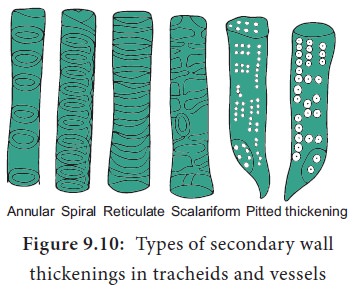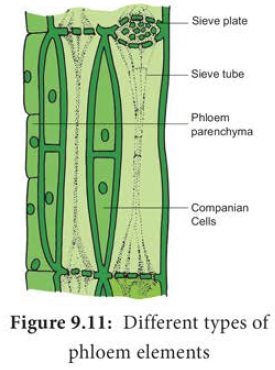Chapter: 11th Botany : Chapter 9 : Tissue and Tissue System
Complex Tissues: Xylem and Phloem
The Permanent tissues develop from apical meristem. They lose the power of cell division either permanently or temporarily. They are classified into two types:
1. Simple permanent tissues.
2. Complex permanent tissues.
Complex Tissues
A complex
tissue is a tissue with several types of cells but all of them function
together as a single unit. It is of two types – xylem and phloem.
Xylem
The xylem
is the principal water conducting tissue in a vascular plant. The term xylem
was introduced by Nageli(1858) and
is derived from the Gk. Xylos – wood.
The xylem which is derived from Procambium is called primary xylem and the xylem which is derived from vascular cambium
is called secondary xylem. Early
formed primary xylem elements are
called protoxylem, whereas the later formed primary xylem elements are called
metaxylem.
Protoxylem
lies towards the periphery and metaxylem that lies towards the centre is called
Exarch. It is common in roots.
Protoxylem
lies towards the centre and meta xylem towards the periphery this condition is
called Endarch. It is seen in stems.
Protoxylem
is located in the centre surrounded by the metaxylem is called Centrarch. In this type only one
vascular strand is developed.
Example: Selaginella sp.
Protoxylem
is located in the centre surrounded by the metaxylem is called Mesarch.In this type several vascular
strands are developed. Example: Ophioglossum
sp.
Xylem Consists of Four Types of Cells
a.
Tracheids
b.
Vessels or Trachea
c.
Xylem Parenchyma
d.
Xylem Fibres

Tracheids
Tracheids
are dead, lignified and elongated cells with tapering ends. Its lumen is
broader than that of fibres. In cross section, the tracheids are polygonal.
There are
different types of cell wall thickenings due to the deposition of secondary
wall substances. They are annular (ring like), spiral (spring like),
scalariform (ladder like) reticulate (net like) and pitted (uniformly thick
except at pits). Tracheids are imperforated cells with bordered pits on their
side walls.
Only
through this conduction takes place in Gymnosperms. They are arranged one above
the other. Tracheids are chief water conducting elements in Gymnosperms and
Pteridophytes. They also offer mechanical support to the plants.
Vessels or Trachea
Vessels
are elongated tube like structure. They are dead cells formed from a row of
vessel elements placed end to end. They are perforated at the end walls. Their
lumen is wider than Tracheids. Due to the dissolution of entire cell wall, a
single pore is formed at the perforation plate. It is called simple perforation
plate, Example: Mangifera. If the perforation plate has many pores, it is
called multiple perforation plate. Example Liriodendron.
The
secondary wall thickening of vessels are annular, spiral, scalariform,
reticulate, or pitted as in tracheids, Vessels are chief water conducting
elements in Angiosperms and absent in Pteridophytes and Gymnosperms. In Gnetum of Gymnosperm, vessels occur. The main function is conduction of water, minerals
and also offers mechanical strength.
Xylem Fibre
The
fibres of sclerenchyma associated with the xylem are known as xylem fibres.
Xylem fibres are dead cells and have lignified walls with narrow lumen. They
cannot conduct water but being stronger provide mechanical strength. They are
present in both primary and secondary xylem. Xylem fibres are also called
libriform fibres.
The
fibres are abundantly found in many plants. They occur in patches, in
continuous bands and sometimes singly among other cells. Between fibres and
normal tracheids, there are many transitional forms which are neither typical
fibres nor typical tracheids. The transitional types are designated as fibre-tracheids. The pits of
fibre-tracheids are smaller than
those of vessels and typical tracheids.
Xylem Parernchyma
The
parenchyma cells associated with the xylem are known as xylem parenchyma. These
are the only living cells in xylem tissue. The cell wall is thin and made up of
cellulose. Parenchyma arranged longitudinally along the long axis is called axial parenchyma. Ray parenchyma is arranged in radial rows. Secondary
xylem consists of both axial and ray parenchyma, Parenchyma stores food
materials and also helps in conduction of water.
Phloem
Phloem is
the food conducting complex tissues of vascular plants. The term phloem was
coined by C. Nageli (1858) The
Phloem which is derived from procambium is called primary phloem and the phloem
which is derived from vascular cambium is called secondary phloem. Early formed
primary phloem elements are called protophloem
whereas the later formed primary phloem elements are called metaphloem. Protophloem is short lived.
It gets crushed by the developing metaphloem.
Phloem Consists of Four Types of Cells
1) Sieve
elements
2) Companion
cells
3) Phloem
parenchyma
4) Phloem
fibres
Sieve Elements
Sieve
elements are the conducting elements of the phloem. They are of two types,
namely sieve cells and sieve tubes.
Sieve Cells
These are
primitive type of conducting elements found in Pteridophytes and Gymnosperms.
Sieve cells have sieve areas on their lateral walls only. They are not
associated with companion cells.
Sieve Tubes
Sieve
tubes are long tube like conducting elements in the phloem. These are formed
from a series of cells called sieve tube elements. The sieve tube elements are
arranged one above the other and form vertical sieve tube. The end wall
contains a number of pores and it looks like a sieve. So it is called as sieve
plate. The sieve elements show nacreous thickenings on their lateral walls.
They may possess simple or compound sieve plates The function of sieve tubes
are believed to be controlled by campanion cells.
In mature
sieve tube, Nucleus is absent. It contains a lining layer of cytoplasm. A special
protein (P. Protein = Phloem
Protein) called slime body is seen in it. In mature sieve tubes, the pores in
the sieve plate are blocked by a substance called callose (callose plug).The conduction of food material takes place through cytoplasmic strands. Sieve
tubes occur only in Angiosperms.

Companion Cells
The thin
walled, elongated, specialized parenchyma cells, which are associated with the
sieve elements, are called companion cells. These cells are living and they
have cytoplasm and a prominent nucleus. They are connected to the sieve tubes
through pits found in the lateral walls. Through these pits cytoplasmic
connections are maintained between these elements. These cells are helpful in
maintaining the pressure gradient in the sieve tubes. Usually the nuclei of the
companion cells serve for the nuclei of sieve tubes as they lack them. The
companion cells are present only in Angiosperms and absent in Gymnosperms and
Pteridophytes. They assist the sieve tubes in the conduction of food materials.
Phloem Parenchyma
The
parenchyma cells associated with the phloem are called phloem parenchyma. These
are living cells. They store starch and fats. They also contain resins and
tannins in some plants. Primary phloem consists of axial parenchyma and
secondary phloem consists of both axial and ray parenchyma. They are present in
Pteridophytes,Gymnosperms and Dicots.
Phloem Fibres (or) Bast Fibres
The
fibres of sclerenchyma associated with phloem are called phloem fibres or bast
fibres. They are narrow, vertically elongated cells with very thick walls and a
small lumen. Among the four phloem elements, phloem fibres are the only dead
tissue. These are the strengthening as well as supporting cells.
Related Topics